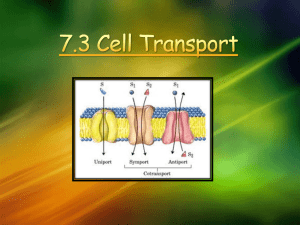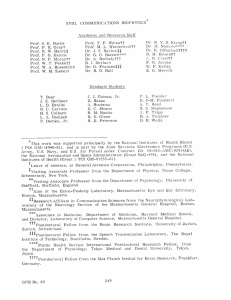第一章细胞
advertisement
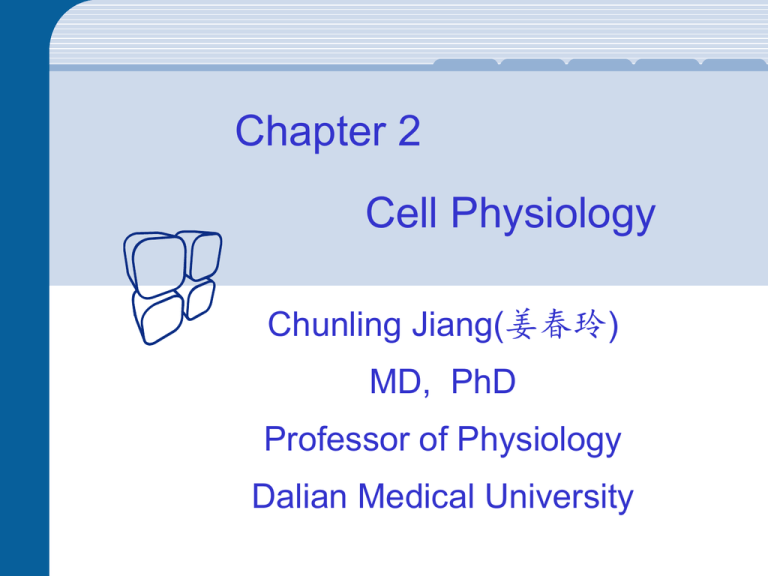
Chapter 2 Cell Physiology Chunling Jiang(姜春玲) MD, PhD Professor of Physiology Dalian Medical University §1 The cell and its function I Membranous Structures of the Cell 1.Most organelles of the cell are covered by membranes composed primarily of lipids and proteins. 2. These membranes include the cell membrane, nuclear membrane, membrane of the endoplasmic reticulum, and membranes of the mitochondria, lysosomes, and Golgi apparatus. 姜春玲博士 大连医科大学 Cell membrane lipids Proteins 42% Phospholipids 25% Cholesterol 13% other lipids 4% 55% Carbohydrates 3% 姜春玲博士 大连医科大学 3. Function (1) function of the lipids (2) cell membrane proteins (3) Function of the carbohydrate 姜春玲博士 大连医科大学 4. structure of the cell membrane ---- the fluid mosaic model (Fig.1) It is composed of a lipid bilayer of phospholipids molecules, but with large numbers of protein molecules protruding throug h the layer( globular masses floats in the lipid bilayer). Also carbohydrate moieties are attached to the protein molec ules, the outside of the membrane. 姜春玲博士 大连医科大学 III Transport of substances through the cell membrane 1. Simple diffusion (1) Concept : (2) Example: 姜春玲博士 大连医科大学 2. Facilitated diffusion (1) Concept ◇ Some substances which are insoluble in lipids (water-soluble) through the cell membrane ◇ Down concentration gradient (2) Types carrier-mediated diffusion channel-mediated diffusion 姜春玲博士 大连医科大学 ① Carrier-mediated diffusion Concept: Example: Features: ② channel-mediated diffusion Example: Features: 姜春玲博士 大连医科大学 姜春玲博士 大连医科大学 姜春玲博士 大连医科大学 3. Active transport (1) Concept (2) Features (3) Types Primary Active Transport Secondary Active Transport (4) Example of Primary Active Transport Na pump ② Function: 姜春玲博士 大连医科大学 §3 Electrical phenomena 1.Excitability (1) Concept: (2) Signicance: 2. Excitable tissue ------ muscle, nerve or gland 姜春玲博士 大连医科大学 3.threshold (1)Exp. (2)Concept: (2)significance 4.The relation between the excitability and the threshold 5.subthreshold and superthreshold 姜春玲博士 大连医科大学 1.Resting potential (RP) (1) Exp. (Fig.1 and Fig.2) Animal: Calamary (2) Concept: Difference in voltage across the membrane of a cell, with the inside being negative relative to the outside of the cell at rest. (3) Normal Value: In neurons, it is usually about -70 mV, in muscle cells, it is about -90 mV. 姜春玲博士 大连医科大学 2. Action potential (AP) (1) Exp. (Fig.3 and Fig.4) (2) Concept: rising phase --- depolarization phase Spike potential falling phase --- repolarization phase AP after- depolarization After potential after-hyperpolarization 姜春玲博士 大连医科大学 The Action Potential Action Potential: a rapid depolarization and slight reversal of the usual potential (- 70 mV) 姜春玲博士 大连医科大学 (3) All or None phenomenon A stimulus of threshold or suprathreshold intensity applied to a s ingle nerve fibers, the size, amplitude and velocity of an action potential are independent of the intensity of the stimulation that caused it . A stimulus of threshold or suprathreshold intensity applied to a s ingle nerve fibers always produces an action potential of constant amplitude and the amplitude remains constant along the propagation path. The propagation velocity of a single nerve fiber also remains constant. 姜春玲博士 大连医科大学 4. Mechanism of RP genesis RP and equilibrium potential of K+ (EK). 5.Mechanism of AP genesis AP and ENa+ 姜春玲博士 大连医科大学 6. Action potential propagation an unmyelinated axon ------ the Local Circuit Flow or Local Current theory (Fig.5) a myelinated axon -----------the “Saltatory Conduction “ theory (Fig.6) 姜春玲博士 大连医科大学 7. Local response (1)Concept: With a subthreshold stimulus, a localized membrane depolarization appears at the site of stimulation, which is called a local response. 姜春玲博士 大连医科大学 (2)Features: It is nonpropagated local depolarizaition that only spread a few mm to either sides of the point of stimulation, which is called an electronic conduction. During the local response, the excitability of the nerve is increased and two local responses , elicited by two subthreshold stimuli in rapid succession, can summate and initiate an AP. 姜春玲博士 大连医科大学 8. Refractory Period: 1.Exp. (Fig.7) 2.Phases (1)绝对不应期 (Absolute refractory period, ARP) ① Concept:The period during which a second action potential can not be elicited, even with a strong stimulus, is called the a bsolute refractory period. ② Features: ③ Significance: 姜春玲博士 大连医科大学 (2)Relative refractory period, RRP (3)supernormal period,SNP (4)Subnormal period 姜春玲博士 大连医科大学 §4 Neuromuscular transmission 姜春玲博士 大连医科大学 Neuromuscular Junction (Fig.8) APs reaches the motor nerve terminals ↓ Ca2+ influx ↓ Liberation of ACh into synaptic cleft ↓ ACh acts on N2 receptors (on muscle cell membrane) ↓ It increases membrane permeability to Na+ and K+ ↓ Producing end plate potential ↓ 姜春玲博士 大连医科大学 Generation of AP in the muscle fiber excitation contraction coupling Causing muscle contraction 姜春玲博士 大连医科大学 • ACh is quickly destroyed by cetylcholinesterase • 终板电位(End-plate potential, EPP) 1. Concept: 2. Features: 姜春玲博士 大连医科大学 §2 Signaling I Receptor – channel 偶联系统 Example 1:Neuromuscular junction Example 2: IPSP Structure of the Neuromuscular Junction N-Ach R: MW:290KD, 5 units, Neuromuscular Junction (Fig.8) APs reaches the motor nerve terminals ↓ Ca2+ influx ↓ Liberation of ACh into synaptic cleft ↓ ACh acts on N2 receptors (on muscle cell membrane) ↓ It increases membrane permeability to Na+ and K+ ↓ Producing end plate potential ↓ Generation of AP in the muscle fiber excitation contraction coupling Causing muscle contraction II Receptor-G protein-effector enzyme = Signal transduction mediated by G-protein-linked receptor Receptor-G protein –AC pathway Receptor-G protein –PLC pathway 1. receptor =G protein –linked receptor 2.G protein 3. Effector enzyme 4. Pathways (1)Receptor-G protein –AC pathway First messenger ↓ receptor ↓ Gs protein ↓ (+) AC ↓ ATP cAMP ↓ PKA ↓ Cell’s response (P30 Fig.2-9) (2)Receptor-G protein –PLC pathway (P32 Fig.2-10) First messenger ↓ receptor ↓ G protein ↓ (+) PLC ↓ PIP2 IP3 + DG ↓ Ca2+ ↓ PKC Ca2+-CaM ↓ Cell’s response III Signal transduction mediated by enzyme-linked receptor 1.酪氨酸激酶受体(Tyrosine kinase receptor, Tk受体) ( P34 Fig.2-12 ) (1) Function: (2) Example: (3)pathway cell proliferation and differentiation insulin NGF,EGF,FGF,GSF 2.鸟苷酸环化酶受体(Guanylyl cyclase receptor,GC受体) (1)Function: the receptor functions both as a receptor and as a guanylyl cyclase to catalyse the formation of cyclic GMP (cGMP) in the cytoplasm. (2)Example : ANP and NO (3) Pathway
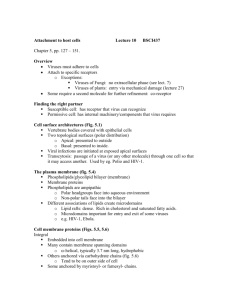



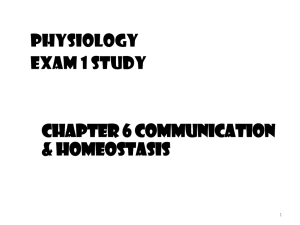


![Shark Electrosense: physiology and circuit model []](http://s2.studylib.net/store/data/005306781_1-34d5e86294a52e9275a69716495e2e51-300x300.png)

